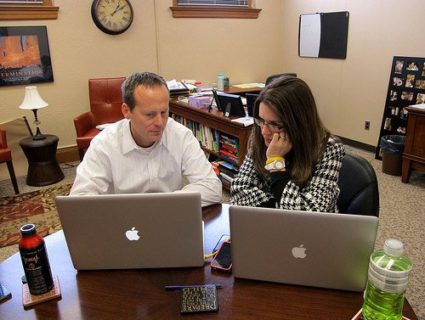
Significant and long‐lasting changes occur when a school’s “policies, practices, culture, and funding” are structured to facilitate the integration of educational technology. The distributed leadership model is a way to continue supporting teacher leaders and implement shifts in teaching strategies. Allowing teacher voice in choices that are school based and implemented through professional learning impacts the classroom through teachers transforming their practice. In Transforming Professional Learning in Washington State, it is important that teachers be provided with effective and supportive professional development (PD).
Instruction is more important than technical mastery of technology, although both elements are essential. Successful PD programs provide ongoing support through coaching; programs that include coaching or mentoring are more likely to implement new instructional methods. Other effect supports are professional learning communities and information repositories. Online and Open Educational Resources can provide continuous and convenient access to resources. Motivators for teachers including Badges, or micro-credentials, provided through PD that is personalized, flexible, and embedded in classroom practice are becoming more prevalent. There are other best practices examples of PD in the article, The future of PD: a collection of best practices.
Some of the strategies are listed below:
- Gamified PD: simple, user-friendly, and fun: the apple PD trainer of trainers model and tech trek
- A personalized approach: the differentiated approach to learning technology offering “a wide variety of learning opportunities” in different learning styles is key.
- Minimizing confusion with chunking: concentrate on one or two specific things at a time, more confident, and it will be easier to keep moving forward.
- Teaching strategies, not tools: training them to implement technology in their classrooms as a way to meet outcomes
- Teacher-leaders: serve as change agents in the transition to dynamic digital learner-centered environments.
- Take the time to lead by example: asynchronous virtual, live via distance learning, or face to face
- Next-generation PD now: achieving standards, establishing a culture of learning, and personalizing learning
- Empower the teacher: One-size-fits-all is gone, flexibility, breadth of options, and convenience are
- Horse before the cart PD -the why: collaboration, communication, critical thinking, and creativity
- The how: build teacher collaboration into everything.
By understanding appropriate pedagogical practices for using technology, teachers can effectively incorporate technology.
References
Bishop, D., Lumpe, A., Henrikson, R., & Crane, C. (2016). Transforming Professional Learning in Washington State–Project Evaluation Report.
Classroom Technology News | Educational Apps | Bloom’s Taxonomy | techlearning.com. (n.d.). THE FUTURE OF PD: A COLLECTION OF BEST PRACTICES. Retrieved March 16, 2017, from http://www.techlearning.com/resources/0003/the-future-of-pd-a-collection-of-best-practices/70155
Professional Development for Technology Integration. (2017, February 20). Retrieved March 06, 2017, from http://www.hanoverresearch.com/2014/07/02/professional-development-for-technology-integration/